Psychoanalysis of Myth 4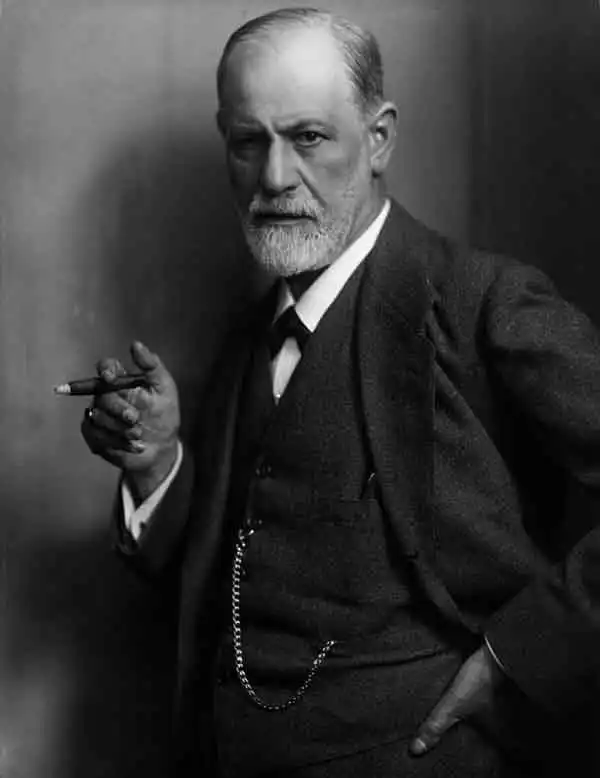
Freud's Moses and Monotheism
That conviction I acquired a quarter of a century ago, when I wrote my book on Totem and Taboo (in 1912), and it has only become stronger since. From then on I have never doubted that religious phenomena are to be understood only on the model of the neurotic symptoms of the individual, which are so familiar to us, as a return to of long-forgotten important happenings in the primeval history of the human family, that they owe their obsessive character to that very origin and therefore derive their effect on mankind from the historical truth they contain.
He gives a narrated form of summary of the primordial event of the father murder, more precisely and to the point than in his earlier book, and begins it with the following reservation, which was more vaguely implied in Totem and Taboo:
The next decisive step towards changing this first kind of "social" organization lies in the following suggestion: the brothers who had been driven out and lived together in a community clubbed together, overcame the father, and — according to the custom of those times — all partook on his body.
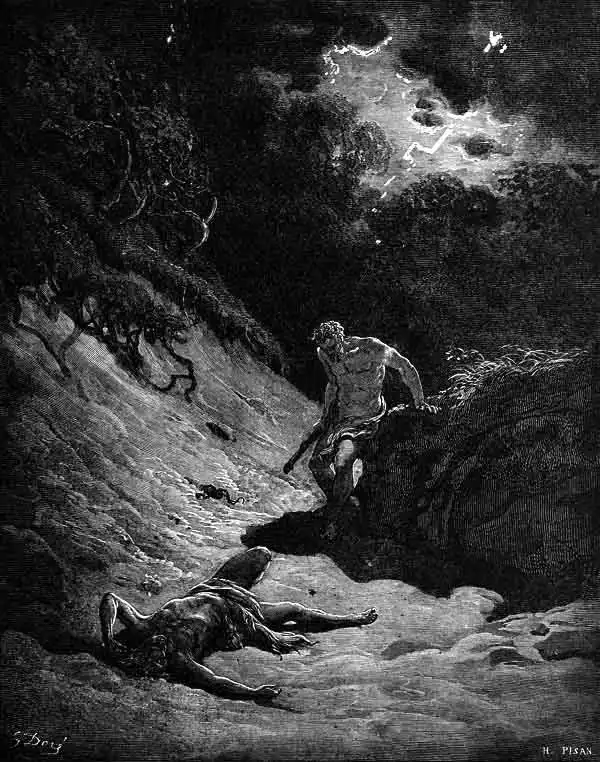 Cain kills Abel. Bible illustration by Gustave Doré, 1866. In Moses and Monotheism, Freud expands and clarifies his theory somewhat. He specifies the stages gone through by mankind as a whole, in comparison to the individual neurotic stages of "early trauma — defense — latency — outbreak of the neurosis — partial return of the repressed material." The analogy makes additional sense, since he claims that: "the genesis of the neurosis always goes back to very early impressions in childhood." Also for mankind, the father murder supposedly took place at an early stage, a childhood of sorts, of its development. He describes the process:
As a consequence of this latency, Freud needs to explain how something forgotten can remain through generations, to emerge in people as a very vivid and powerful memory of sorts. In Totem and Taboo he supposed no forgetting of the father murder, on the other hand he did not specify that the memory was kept through the generations. What was implied was an established totemism, containing the trauma of the father murder and continuing to be obeyed, long after the actual event had been forgotten. In Moses and Monotheism he introduces latency, the suppressed memory able to reemerge, and therefore needs to explain this process. Doing so, he comes strikingly close to Carl Jung's theories of the collective unconscious and the archetypes. Freud states very clearly that people did forget about the initial event:
Now, Freud speculates that the individual does not have only personal memories stored in the unconscious, but also: "what he brought with him at birth, fragments of phylogenetic origin, an archaic heritage." He does not try to explain how such a memory can be kept and transported through the generations, but finds support for it in observations of patients. When they react to early traumata, when an Oedipus or castration complex is examined, other than purely personal experiences seem to emerge. These make more sense if regarded as somehow inherited from earlier generations. Freud believes that they are part of what he calls the archaic heritage.
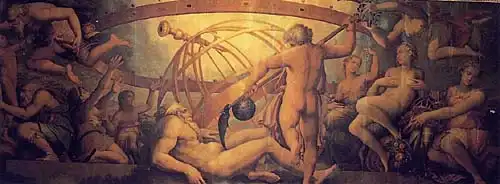 Cronus castrates Uranus, by Giorgio Vasari, 16th Century.
He does admit that the science of biology allows no acquired abilities to be transmitted to descendants, but boldly states: "I cannot picture biological development proceeding without taking this factor into account." He also compares with animals, which he regards as fundamentally not very different from human beings in this aspect — the archaic heritage of the "human animal" may differ in extent and character, but "corresponds to the instincts of animals." What makes a memory enter the archaic heritage is if it is important enough or repeated enough times, or both. Regarding the primeval father murder, he is quite certain:
MosesFreud gives two examples from biblical events, on which to apply his theory: that of Moses and of Jesus. About Moses, Freud claims that he was not Jewish but an Egyptian, befriending a Jewish tribe, taking it out of Egypt and converting it to his monotheistic religion, that of pharaoh Ikhnaton, the Aton religion of a single sun god. The reason for a monotheistic god at all appearing in otherwise abundantly polytheistic Egypt, Freud finds in the imperialistic success of Egypt, immediately preceding the cult of Aton: "God was the reflection of a Pharaoh autocratically governing a great world Empire."Then Freud imagines a fate of Moses, similar to that of the primeval tyrant father:
Later on, Freud has this Jewish tribe meet and join with another, and as part of the compromise between them, they adapted the worship of a volcano-god Jahve, influenced by the Arabian Midianites. In an effort to release themselves of the guilt for having killed Moses, that tribe insisted on proclaiming him the father of this new monotheistic religion. In that way, they were almost accomplishing the father worship, which Freud makes the basis of his theory on the origin of religion. Another consequence was:
JesusFreud moves on to compare the story of Moses with that of Jesus, who was also sacrificed — but willingly, as a symbolic amends for a primordial father murder:
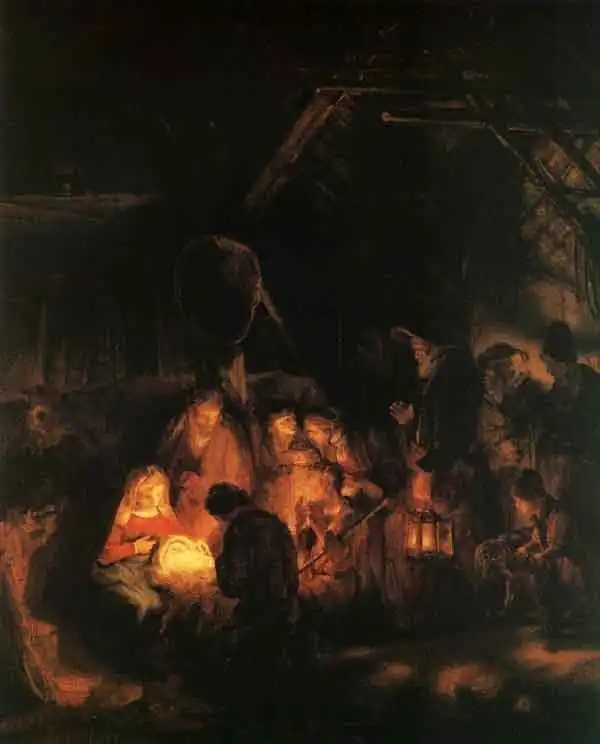 The adoration of the shepherds, by Rembrandt 1646.
Freud finds a significant difference in the fates of Moses and Jesus — the former being a father figure, the latter that of a son. Therefore, he sees the Mosaic religion as essentially focused on the father, whereas Christianity is focused on the son:
Judeo-ChristianNo doubt, Christianity has several elements leading to somewhat similar impressions, with a sacrificed prophet teacher, a ritual meal of the martyr's flesh and blood, et cetera. The killing and dividing of a primal being is a common motif among creation myths — oddly not used as an example by Freud, although he must have come across such examples, for example in the Norse mythology.On the other hand, it is also easy to find myths and religions with little or no trace of such a beginning. Freud's conclusion seems more likely in the sphere of Judeo-Christian religion, with a sole high god of male characteristics worshiped. In religions swarming of gods of both genders — such as the Indian and Japanese ones — the conclusion makes far less sense. Freud's religion is a male one, which he readily admits in Totem and Taboo:
In Moses and Monotheism he slightly altered his views on a mother goddess and a matriarchate, as mentioned above.
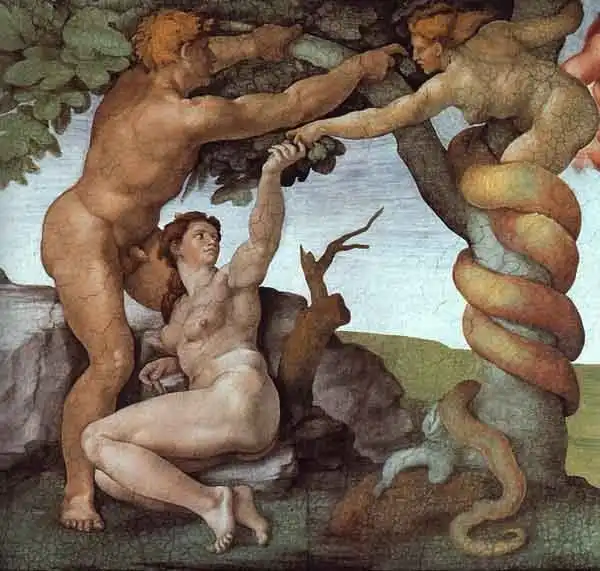 The fall, by Michelangelo 1512.
The social perspectiveNevertheless, Freud's bold thesis gives food for thought. Certainly, sexuality, death, and the complications of blood relations appear as themes in countless myths — as they do just about constantly in our own minds. Man is a flock animal, subject to a lot of struggle in the process of reproduction. There is a competition about the females in several species, including our own, and a strong male might not be satisfied by a first choice only, but strive to exclude the other males from approaching any of the females. If any species would have found the solution of the suppressed males joining and thereby overpowering the leader, this would be most likely with mankind. Freud's theory may be a relevant rendering of a primeval 'democratization' of sorts among savages, allowing for more frequent and evenly distributed procreation — but as a theory of the origin of religion, it seems awkward when applied to the variety of beliefs and rituals around the world.Freud's perspective on religion, ritual and myth has added surprisingly little to research in those fields. It seems to be sort of a dead-end. Whether the worship of a god stems from some kind of savage making amends or not, the theory gives few tools for further understanding. In literature on the subject, it is treated as little more than a parenthesis, mentioned in passing as an oddity that would have been forgotten if it were the work of a lesser known figure than the father of psychoanalysis. I am not sure that Freud's view is unworthy of some additional considerations. What we call religion has been an integrated part of human life as far back as we can see, and the role it has played may very well need tools like Freud's to be understood. The dynamics of the 'herd' or tribe or flock, for one thing, is something more complex than the workings of genetics and instinct — the instruments of psychology and sociology need also to be applied. One valuable ingredient in Freud's theory is that it focuses on the social perspective, not just the individual — much more so than that of Jung. Freud's psychology places the individual right in the middle of the group, of society. Most — if not all — of the individual's psychology is explained as a dynamic and often troublesome relation to the others of the group. Generally speaking, Freud's psychology deals with the individual's frustrations in trying to adapt to the group. In Moses and Monotheism he makes the clear distinction between the individual and the collective perspective, that the psychopathology of human neurosis belongs to individual psychology, "whereas religious phenomena must of course be regarded as a part of mass psychology." This is also evident in the structure and practice of most religions: they regulate how the individual should behave in order to comply with the needs of the group. In this way, religions are social laws, claiming a higher justification. They are also, with their rituals and myths, instruments by which the individual gains some aid in adapting to them. This function of religion, which Freud is no stranger to, can be approached by his method, and a continued development of it. This is less likely to take place within the field of psychology, though, than in for example social anthropology, which deals with man's behavior in a more concrete setting.
NEXTCarl G. Jung
Psychoanalysis of Myth
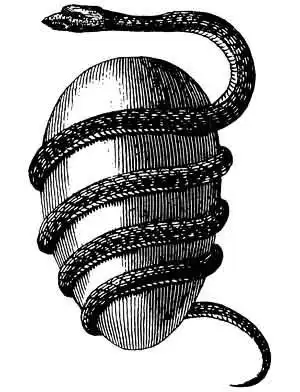
MYTH
IntroductionCreation Myths: Emergence and MeaningsPsychoanalysis of Myth: Freud and JungJungian Theories on Myth and ReligionArchetypes of Mythology - the bookPsychoanalysis of Mythology - the bookIdeas and LearningCosmos of the AncientsLife Energy EncyclopediaOn my Creation Myths website:
Creation Myths Around the WorldThe Logics of MythTheories through History about Myth and FableGenesis 1: The First Creation of the BibleEnuma Elish, Babylonian CreationThe Paradox of Creation: Rig Veda 10:129Xingu CreationArchetypes in MythAbout CookiesMy Other WebsitesCREATION MYTHSMyths in general and myths of creation in particular.
TAOISMThe wisdom of Taoism and the Tao Te Ching, its ancient source.
LIFE ENERGYAn encyclopedia of life energy concepts around the world.
QI ENERGY EXERCISESQi (also spelled chi or ki) explained, with exercises to increase it.
I CHINGThe ancient Chinese system of divination and free online reading.
TAROTTarot card meanings in divination and a free online spread.
ASTROLOGYThe complete horoscope chart and how to read it.
MY AMAZON PAGE
MY YOUTUBE AIKIDO
MY YOUTUBE ART
MY FACEBOOK
MY INSTAGRAM
MY TWITTER
STENUDD PĹ SVENSKA
|
 Archetypes of Mythology
Archetypes of Mythology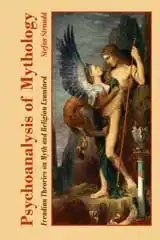 Psychoanalysis of Mythology
Psychoanalysis of Mythology